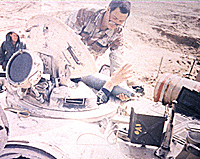 |
 The Tawakalna Division was assessed to be at 25% strength and combat ineffective. With the screening force swept aside, the VIIth Corps smashed into the Medina and Hammurabi Armored divisions of the Republican Guards before they could reach Basrah. A total of 11 Iraqi divisions were destroyed by VIIth Corps before a cease fire was declared at 0800 hours February 28th.
The Tawakalna Division was assessed to be at 25% strength and combat ineffective. With the screening force swept aside, the VIIth Corps smashed into the Medina and Hammurabi Armored divisions of the Republican Guards before they could reach Basrah. A total of 11 Iraqi divisions were destroyed by VIIth Corps before a cease fire was declared at 0800 hours February 28th.
At right, removing ammo from Iraqi tanks.
The VIIth Corps' mission of destroying the Republican Guard Forces Corps was successfully completed, and the strategic objective of liberating Kuwait and removing the Iraqi Army as a threat to the region was also a resounding success. (Desert Jayhawk, p. 22)
The long term significance of the Coalition victory over Iraq will depend on future political resolution to the region's conflicts. As of this writing, Kuwait is still autonomous, and Iraq is still weak. The long term lessons of the Battle of Ghazlani, and dozens of other battles like it fought during the "100 Hour War," are clear. Tactical commanders on the modern technology dominated battlefield are still subject to the same blunders, misjudgments, and the general fog of war that has plagued warriors and leaders for centuries.

At right, Iraqi prisoners march to internment. The last in line was the "aristocratic" Iraqi commander, who initially refused to place his hands on the shoulders of his "common" men. He finally relented to place one hand after some diplomacy--a US officer with a .45 convinced him.
At Ghazlani, the blunders, misjudgments, and fog of war were overcome by three key factors: (1) Overwhelming technical superiority of the U.S. weapons systems. (2) The U.S. commander's cautious but effective application of all of his combat power, and above all, (3) A complete disintegration of Iraqi unit cohesion and combat morale.
Large Iraqi POW (EPW) Photo
Works Cited
OFFICIAL DOCUMENTS : DESERT STORM, 3RD ARMORED DIVISION
ANNEX B (INTEL) TO 4-18 OPORD 91-1: (Intelligence annex for TF 4-18's Operation order), USAIS, 1991.
Hamer, Michael, 1LT, IN, Scout Platoon Leader, TF 4-18 INF, 2/3AD, Interview by CPT P. F. Panzeri, USAIS, 1991
Jones, Thomas, 1LT, IN, Mortar Platoon Leader, TF 4-18 INF, 2/3AD, Interview by CPT P. F. Panzeri, USAIS, 1991.
Leonard, Robert, MAJ, IN, Combat Trains Commander, TF 4-18 INF, 2/3AD, Interview by CPT P. F. Panzeri, USAIS, 1991
LOG OF EVENTS: BN TOC: TF 4-18 INF 3/3AD, BATTLE OF GHAZLANI, 24-27 FEB 1991. (Merged Time Line of TF S-2 and S-3 LOGS) by CPT P. F. Panzeri, USAIS, 1991.
S-2 Intelligence Summary Log: TF 4-18 INF, 2/3AD, USAIS, 1991.
S-3 Operations Log, 2BDE, 3AD, USAIS, 1991.
TF 4-18 AAR: After Action Review report and notes TF 4-18 after Ghazlani, by CPT P. F. Panzeri, USAIS, 1991.
TF 4-18 LOG: S-3 Operations Log, TF 4-18 INF, 2/3AD, USAIS, 1991.
TF 4-18 OPORD 91-1: General Operation Order (initial), for Task Force 4-18 Infantry, 2BDE, 3AD, JAN 1991, USAIS, 1991.
TF 4-18 OPORD 91-010: Final (Detailed) Operation Order, for Task Force 4-18 Infantry, 2BDE, 3AD, JAN 1991, USAIS, 1991.
Transcript of Radio Traffic: Task Force 4-18 INF 2/3AD, USAIS by CPT P. F. Panzeri, USAIS, 1991.
2/3AD AAR: After Action Review report and notes 2BDE, 3AD, after Ghazlani, by CPT P. F. Panzeri, USAIS, 1991.
2/3AD OPLAN 91-1: Operation Order, initial, for 2BDE, 3AD, JAN 1991, USAIS, 1991.
3AD OPLAN 91-1: Operation Order, initial, for 3rd Armored Division, JAN 1991, USAIS, 1991.
More Ghazlani
Back to Veteran Campaigner List of Issues
Back to Master Magazine List
© Copyright 1997 by Pete Panzeri.
This article appears in MagWeb (Magazine Web) on the Internet World Wide Web.
Other military history articles and gaming articles are available at http://www.magweb.com
|
 The Tawakalna Division was assessed to be at 25% strength and combat ineffective. With the screening force swept aside, the VIIth Corps smashed into the Medina and Hammurabi Armored divisions of the Republican Guards before they could reach Basrah. A total of 11 Iraqi divisions were destroyed by VIIth Corps before a cease fire was declared at 0800 hours February 28th.
The Tawakalna Division was assessed to be at 25% strength and combat ineffective. With the screening force swept aside, the VIIth Corps smashed into the Medina and Hammurabi Armored divisions of the Republican Guards before they could reach Basrah. A total of 11 Iraqi divisions were destroyed by VIIth Corps before a cease fire was declared at 0800 hours February 28th.
